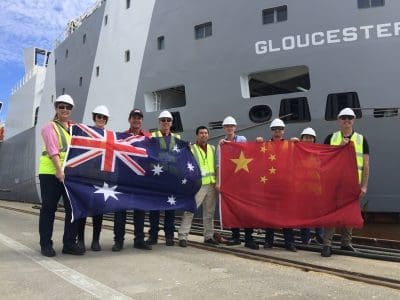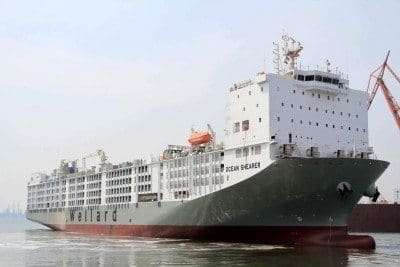China’s recent rise to become the largest importer of Australian boxed beef has corresponded with the growing influence it is also now exerting over Australia’s beef cattle export trade – not as a customer as many initially expected, but as an investor in Australian live exporting companies.
Some estimate Chinese ownership could now control as much as 50 percent of Australia’s live cattle export capacity, a rapid recent development that has dramatically affected competitive dynamics in the trade, and raised concerns about longer-term impacts.
China was hyped to become a major buyer of Australian feeder and slaughter cattle when a new trade deal was struck between the two countries in 2015, prompting confident predictions at the time Australia could soon be shipping more than one million beef cattle a year to the world’s most populous nation.
However, four years later, export numbers have yet to reach a fraction of that volume, having exceeded no more than 30,000 slaughter cattle in a single year.
Working against greater trade volumes have been unviable protocol restrictions imposed by China and higher Australian cattle prices, while frosty relations between both Governments have not been conducive to a growing trade either.
But while China’s growth as a customer has fallen well short of where some thought it may be four years ago, it has still managed to exert strong influence over Australia’s livestock export sector in a different way – as an investor in Australian live export companies.
Several deals in recent years have seen Chinese-backed investment take ownership and control of an increasingly large percentage of Australia’s live export capacity.
Some examples include, all of which occurred in 2017 as hype around the future of the slaughter (and feeder) cattle trade to China was building, include:
-
- China’s Fulida group became the largest shareholder of Wellard, currently holding 24.5pc of voting shares (Since that investment Wellard has posted ongoing financial losses and has withdrawn from livestock exporting to focus exclusively on chartering its vessels).
-
 Chinese investors and Australian managers bought North Australian Cattle Company from Elders (A number of the Australian managers have since left the business, with Patrick Underwood departing in April and more including Hamish Shannon and Matt Reed leaving last month. There has been no public confirmation yet as to who may replace them at NACC or what their own future plans in the industry may be).
Chinese investors and Australian managers bought North Australian Cattle Company from Elders (A number of the Australian managers have since left the business, with Patrick Underwood departing in April and more including Hamish Shannon and Matt Reed leaving last month. There has been no public confirmation yet as to who may replace them at NACC or what their own future plans in the industry may be).
-
- The Chinese backed Harmony Agriculture and Food Company (HAAFCO) created a new live export company called Phoenix Exports. (The Phoenix business was halted last year with HAAFCO blaming slower than anticipated take up of exports to China. Last month a NSW feedlot operator commenced legal action against HAAFCO over alleged non-payment of debts totalling $5.4 million, followed by news the company was placed into liquidation last Friday.)
-
- In the same year Chinese owned consortium Sino Marine Livestock Shipping converted two bulk carriers into livestock vessels, the Yangtze Harmony and Yangtze Fortune, and launched them into the Australian livestock shipping trade, working closely with Phoenix at the time.
-
- In 2017 Singapore-headquartered Yarra Corporation, which has its own meat processing facility and distribution network in China, took a controlling stake in South East Asian Livestock Services. While definitive numbers are hard to ascertain, trade talk suggests SEALS has significantly increased the trade volumes it is exporting into South East Asia following the partnership with Yarra Corporation.
Most, if not all, of the Chinese investors are also Chinese importers who have built new feedlots and abattoirs within 50km of China’s ports, as per Chinese protocol requirements, and have taken the opportunity to take greater control of the Australian export supply chain in anticipation of the expected trade growth to China.
But while their primary focus – it seems fair to assume – is on the Chinese market, and helping to achieve long-term Chinese Government policy around food security, that trade has not opened up as they undoubtedly believed it would.
As a result Chinese owned/controlled exporters have had to continue competing for South East Asian markets as they wait for China to develop as a volume market, adding to crowded competitive environment at a time when trade volumes were falling ( due to factors such as Indonesia opening its market to imports of cheap frozen Indian Buffalo Meat and buyers resisting increased Australian cattle prices,, forced up by drought and lack of supply).
Falling trade volumes might normally be expected to result in structural rationalisation as a smaller pie forces some competitors out.
However, rather than the sector finding new equilibrium in a lower-volume world, competition among exporters in Indonesia and Vietnam has only ramped up, a situation unlikely to change until China relaxes the protocol restrictions currently preventing greater volumes of slaughter cattle from Australia to flow.
There is nothing wrong or sinister with this new dynamic of course, but the altered environment is causing unforeseen disruptions and turmoil throughout the trade.
Some may dismiss such concerns as the grumblings of disgruntled competitors, but some exporters are privately voicing concern the new dynamic is fostering an environment of self-centred, individualistic, short term deal making at a time when the under-pressure industry desperately needs a collective, long-term vision and well managed growth to assure positive outcomes for both cattle and customers.
“The concern is the longer it takes for the launch of China, and the longer China-focused exporters use South East Asia as a temporary fill-in market, the more structural change we are encouraging, perhaps unwittingly and indirectly, in our traditional markets,” is how one exporter described the situation.
“It is hard to see it being a good outcome if the Australian live export market is one day dependent on China because we’ve allowed the South East Asian markets to fracture and pushed them into alternative supply option in our traditional markets.”
Live export statistics show that Chinese total imports of Australian cattle have grown in the past year, but it is importnat to note that all of that growth has been in dairy and beef breeding cattle, which increased by 73 percent to 107,426 head in the 12 months to July 31.
Imports of slaughter cattle over the same period fell by 24 percent year-on-year to 20,195 head.
Despite investments of millions of dollars in new supply chain infrastructure to support an imported beef cattle trade, the Chinese Government has yet to show any inclination to relax the protocol restrictions that are currently making the trade unworkable from a commercial perspective.
One potential trigger for such a relaxation to happen could be the growing need China now faces to find new sources of protein to fill part of the yawning gap created by the mass culling of pigs as a result of the African Swine Fever outbreak.
Another possible incentive may be the desire to increase cattle imports to offset a potentially impending drop in the the amount of boxed beef entering China in coming months, due to its recent tariff increases on Australian and US beef.
Tariffs on Australian boxed beef jumped last month from 6 percent to 12 percent and will remain at the higher level for the rest of the year after Australia exceeded its annual boxed beef import quota for 2019 on August 17.
China hiked tariffs on US boxed beef by an extra 10 percent on September 1 as a retaliatory step in its ongoing trade war with the US.


The current situation. around the far less than ideal political relationship between Australia and China is severely hampering the trade opportunities and trade flows.
These opportunities are removing upside pricing potential for all parts of the supply chain- we need as individuals / companies / associations etc to be encouraging government Federal / State from local member level up – to identify and develop dialogue with China that highlights our global alliance with USA will not come at the expense of trading / investment relationship with China . Being a strong part of the beef supply chain to 20% of the worlds population is a great position for the future values of our industry .
Indonesia, Vietnam, the Phillipines, Malaysia are the best fit for the Northern Australian live cattle export trade.
Fantastic that China is becoming a significant importer of Australian boxed beef and if the market for the export of live cattle from southern Australia evolves to suit Chinese feedlot demand, good.
Entrepreneurs, take a deep breath.